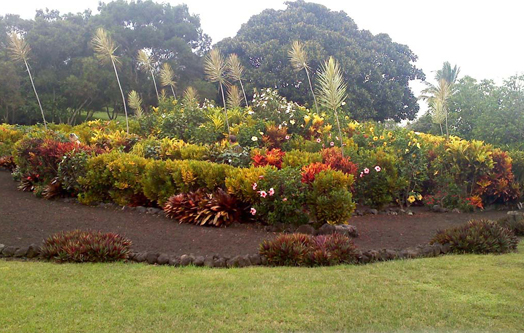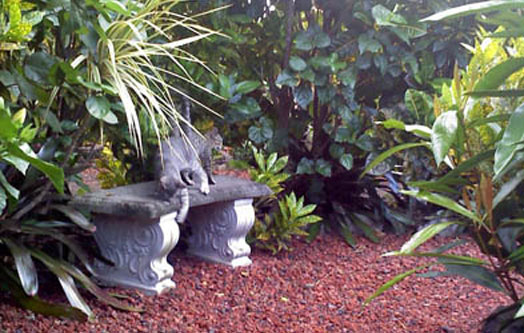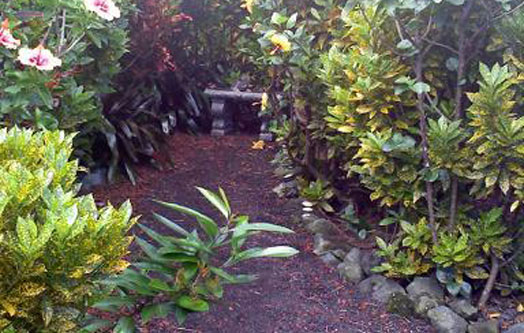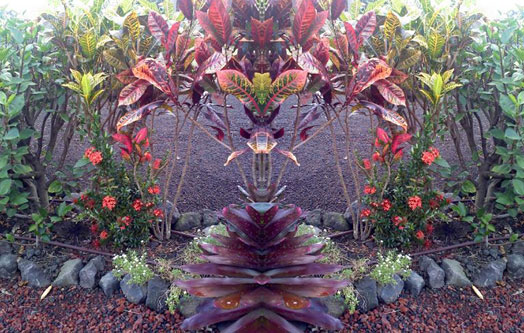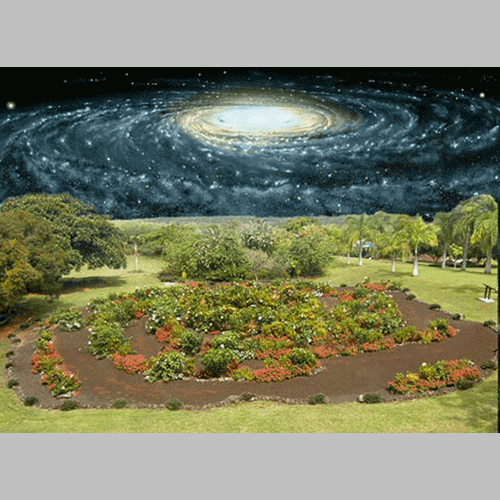
Galaxy Garden composite view
Photomontage by Jon Lomberg
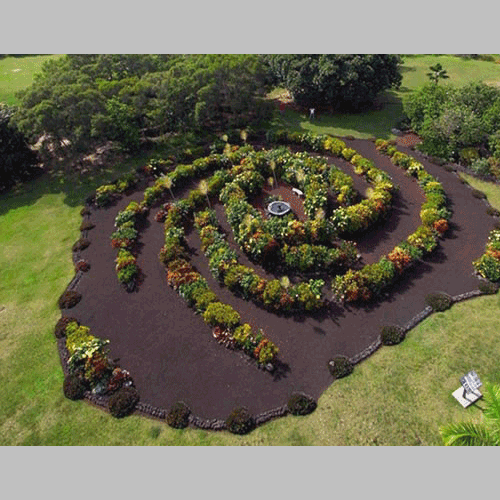
Galaxy Garden aerial view
Kite Aerial Photography by Pierre and Heidy Lesage
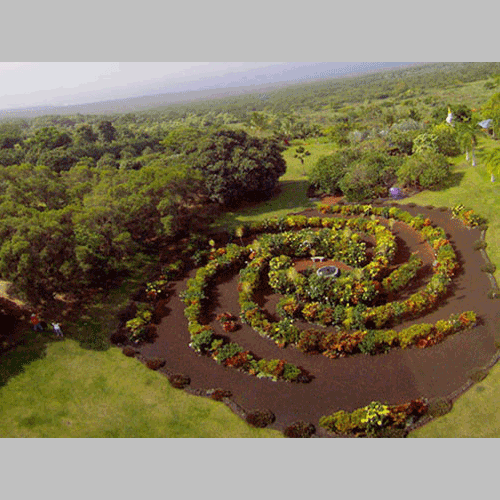
Galaxy Garden aerial view
Kite Aerial Photography by Pierre and Heidy Lesage
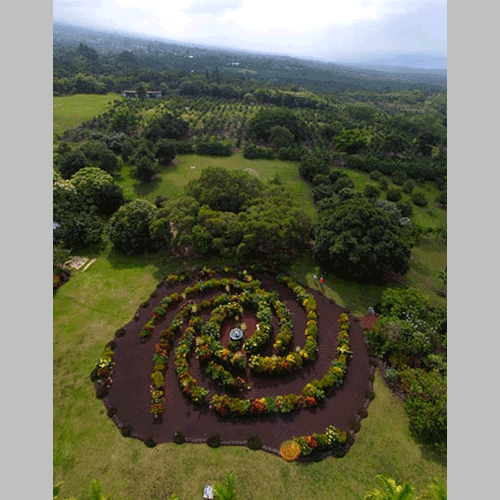
Galaxy Garden aerial view
Kite Aerial Photography by Pierre and Heidy Lesage
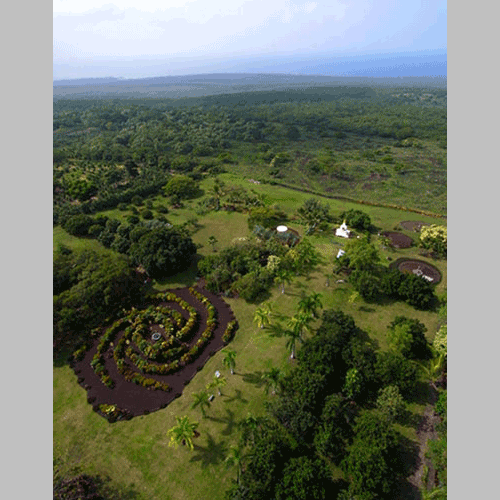
Galaxy Garden aerial view
Kite Aerial Photography by Pierre and Heidy Lesage

Galaxy Garden close-up view
Our Solar System
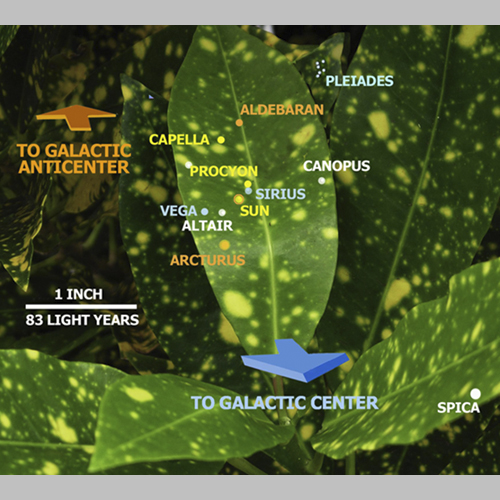
Galaxy Garden close-up view
You Are Here
The Galaxy Garden
The Galaxy Garden is a 100-foot diameter outdoor scale model of the Milky Way, mapped in living plants and flowers and based on current astrophysical data.
Artist Jon Lomberg conceived and designed the garden to encourage scientific education about our place in the Universe.
The Galaxy Garden is located at the Paleaku Peace Gardens Sanctuary in Kona, Hawaii. Paleaku is a non-profit 9-acre botanical garden that facilitates educational and cultural programs.
Major funding for the Galaxy Garden is provided by the Change Happens Foundation.
Seed money for the project was given by the New Moon Foundation.
Photos/Videos of the Galaxy Garden
NEW photo album of Galaxy Garden
NEW videos of Galaxy Garden
Photos on Flickr.com from a Galaxy Garden visitor
An album of photos of the Garden
NEW photo album of Galaxy Garden
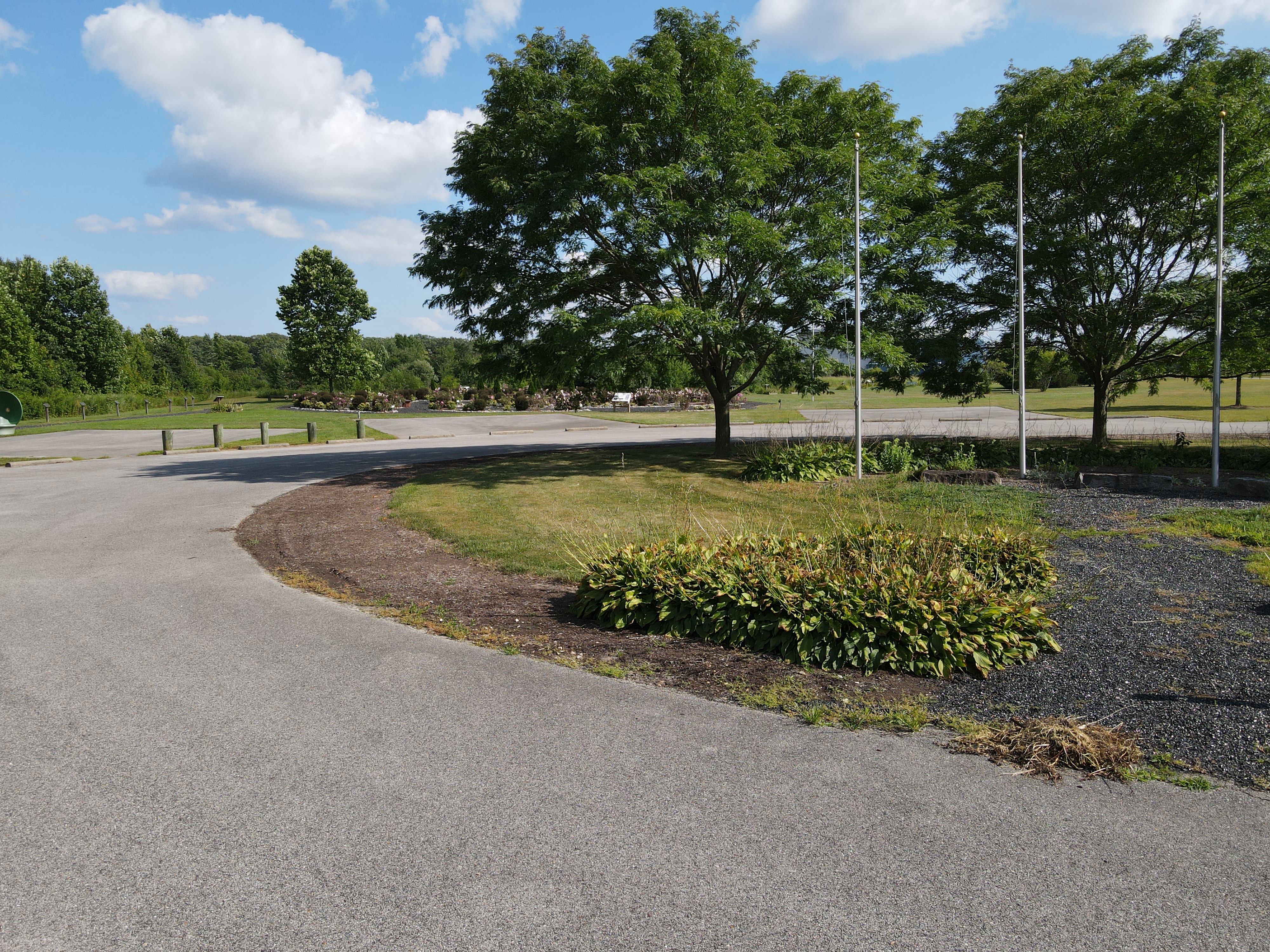
Photo Courtesy of Delaware AeroSpace Education Foundation
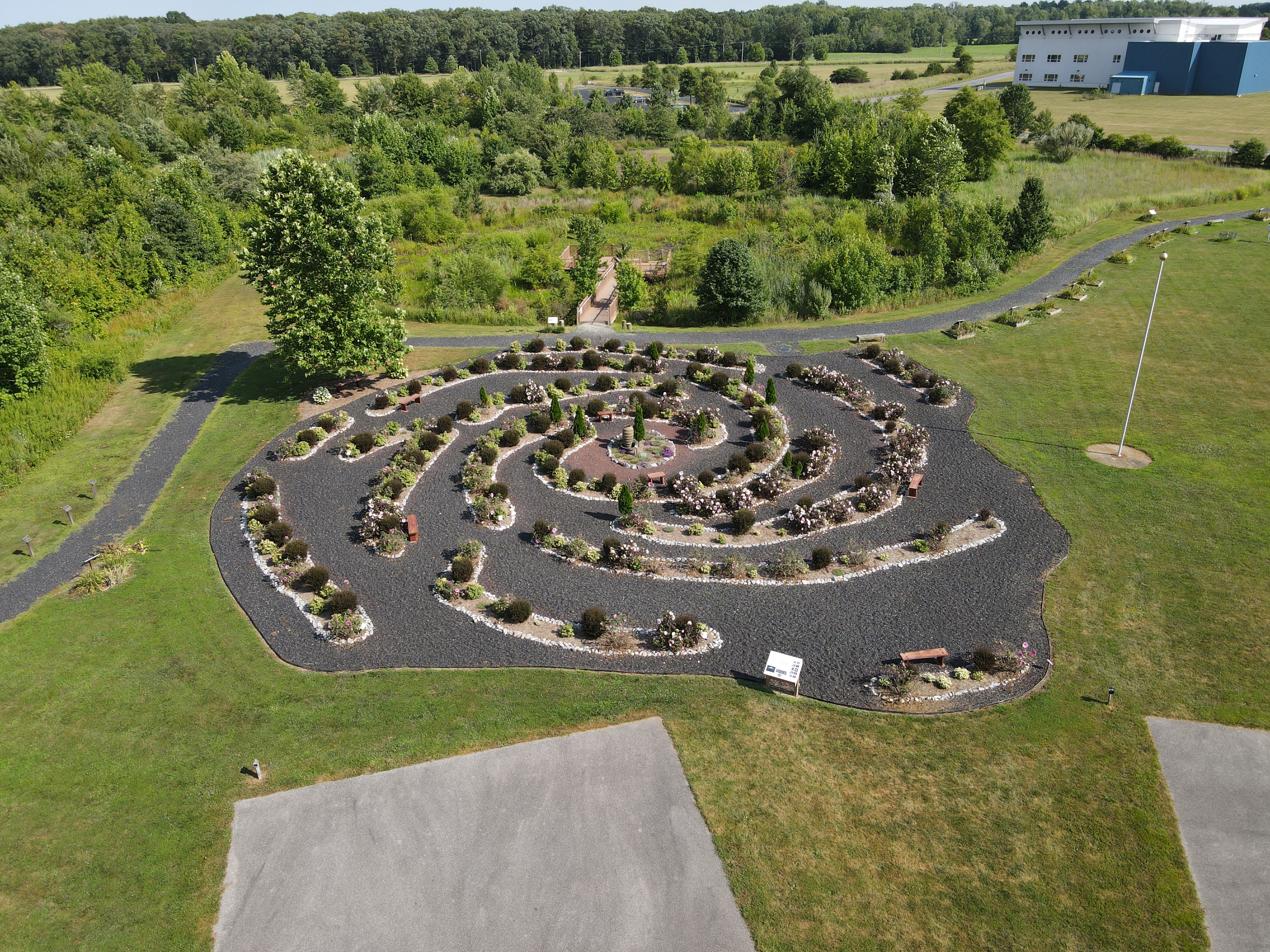
Photo Courtesy of Delaware AeroSpace Education Foundation
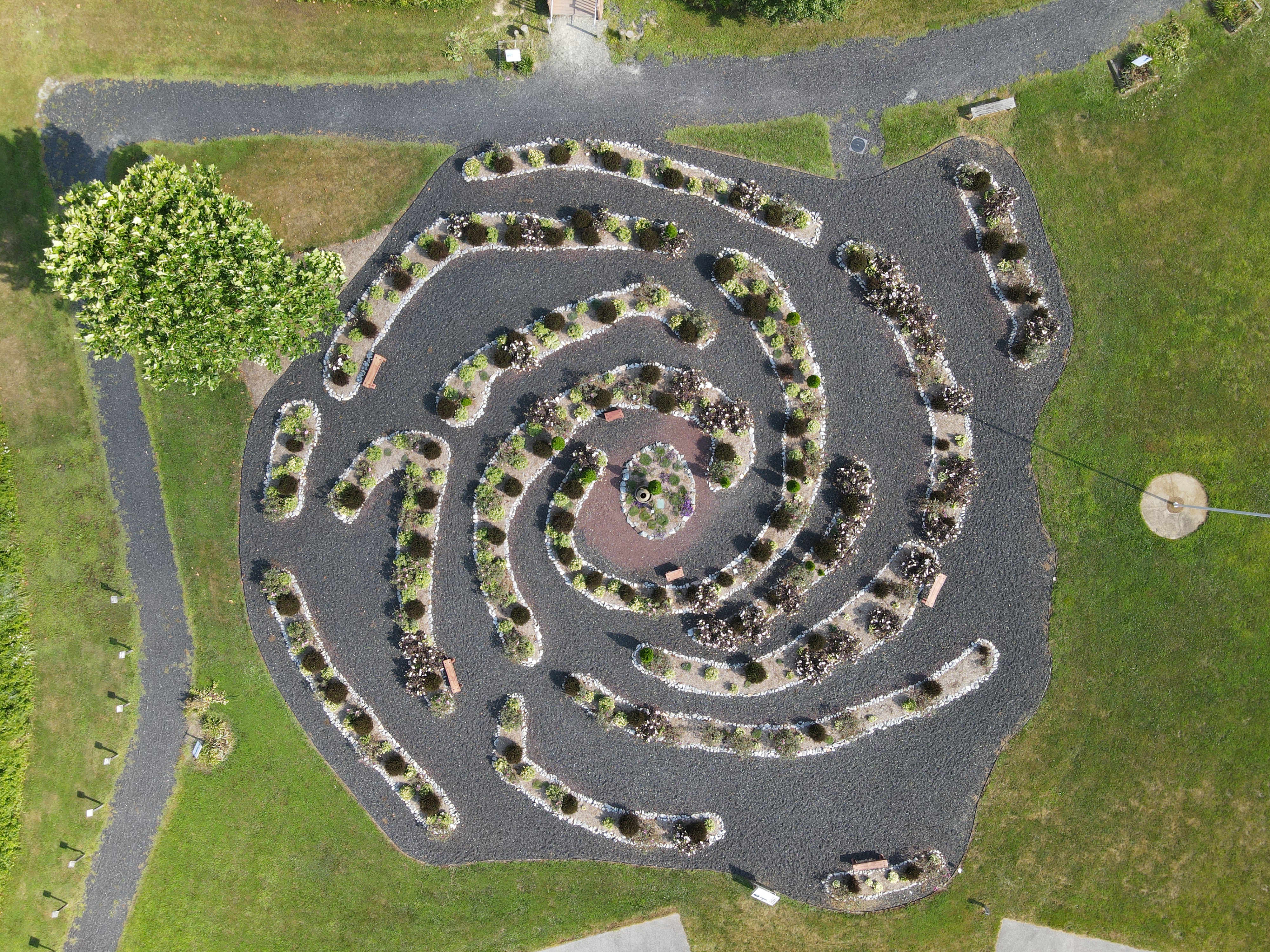
Photo Courtesy of Delaware AeroSpace Education Foundation
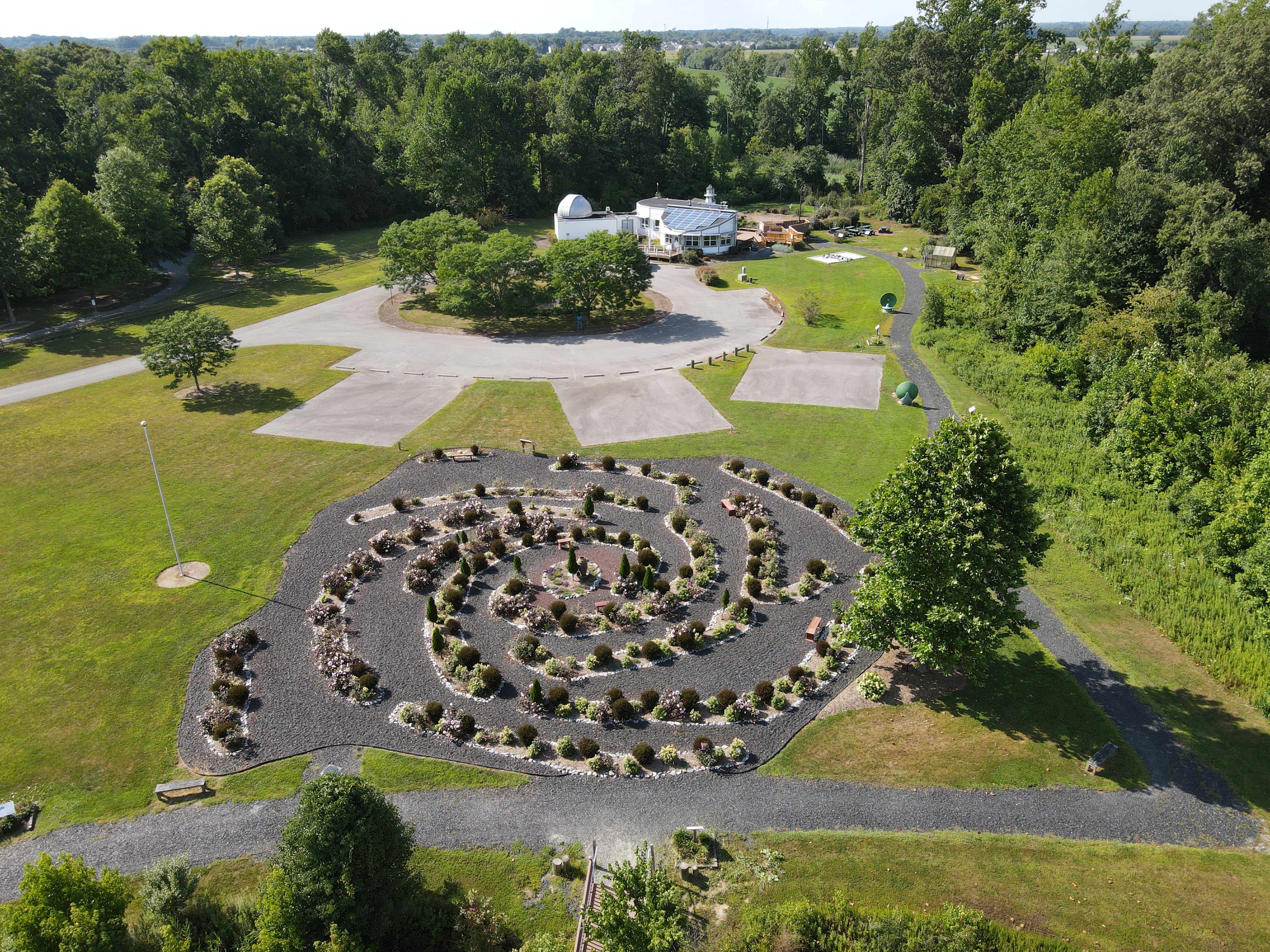
Photo Courtesy of Delaware AeroSpace Education Foundation
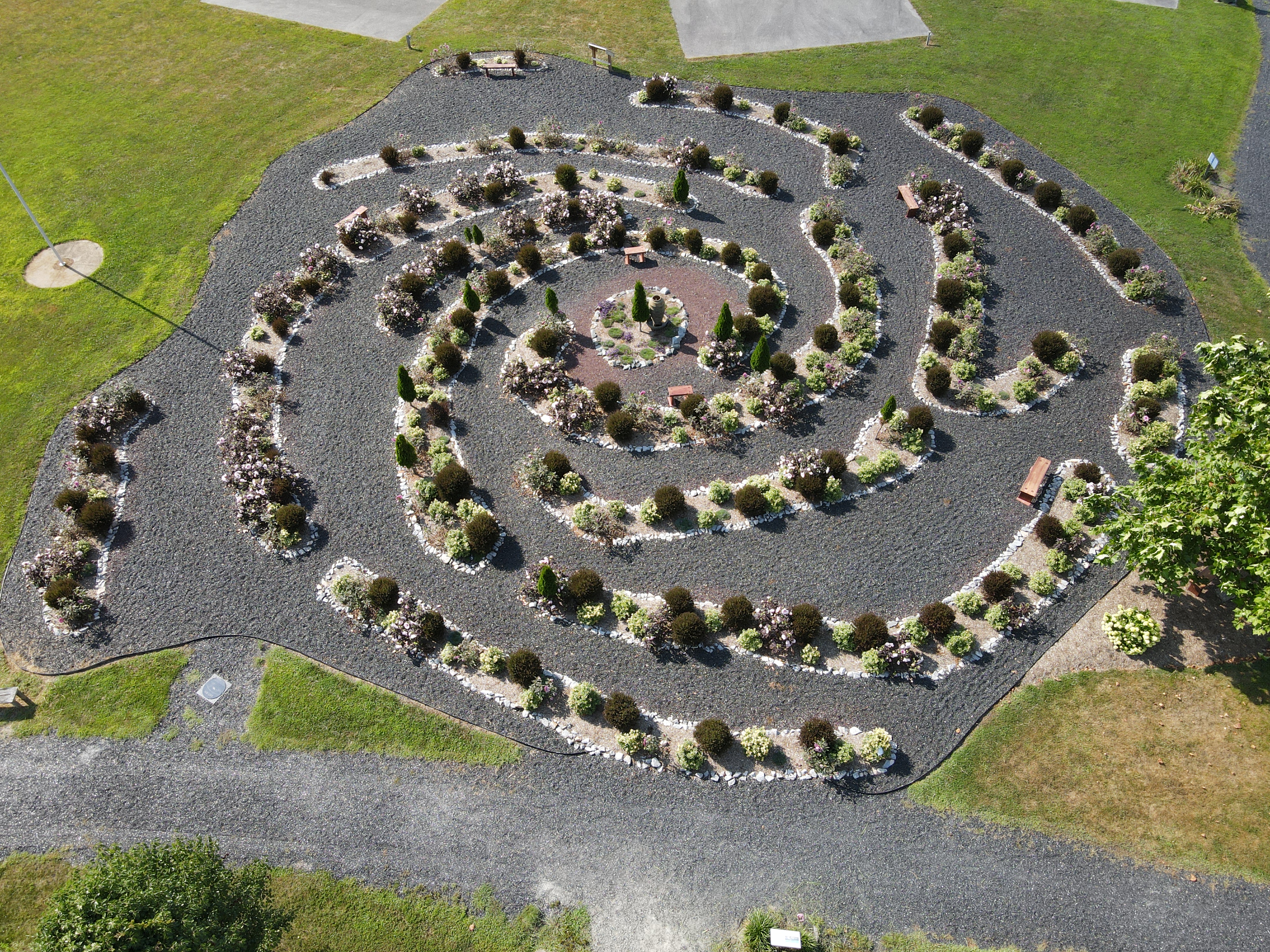
Photo Courtesy of Delaware AeroSpace Education Foundation
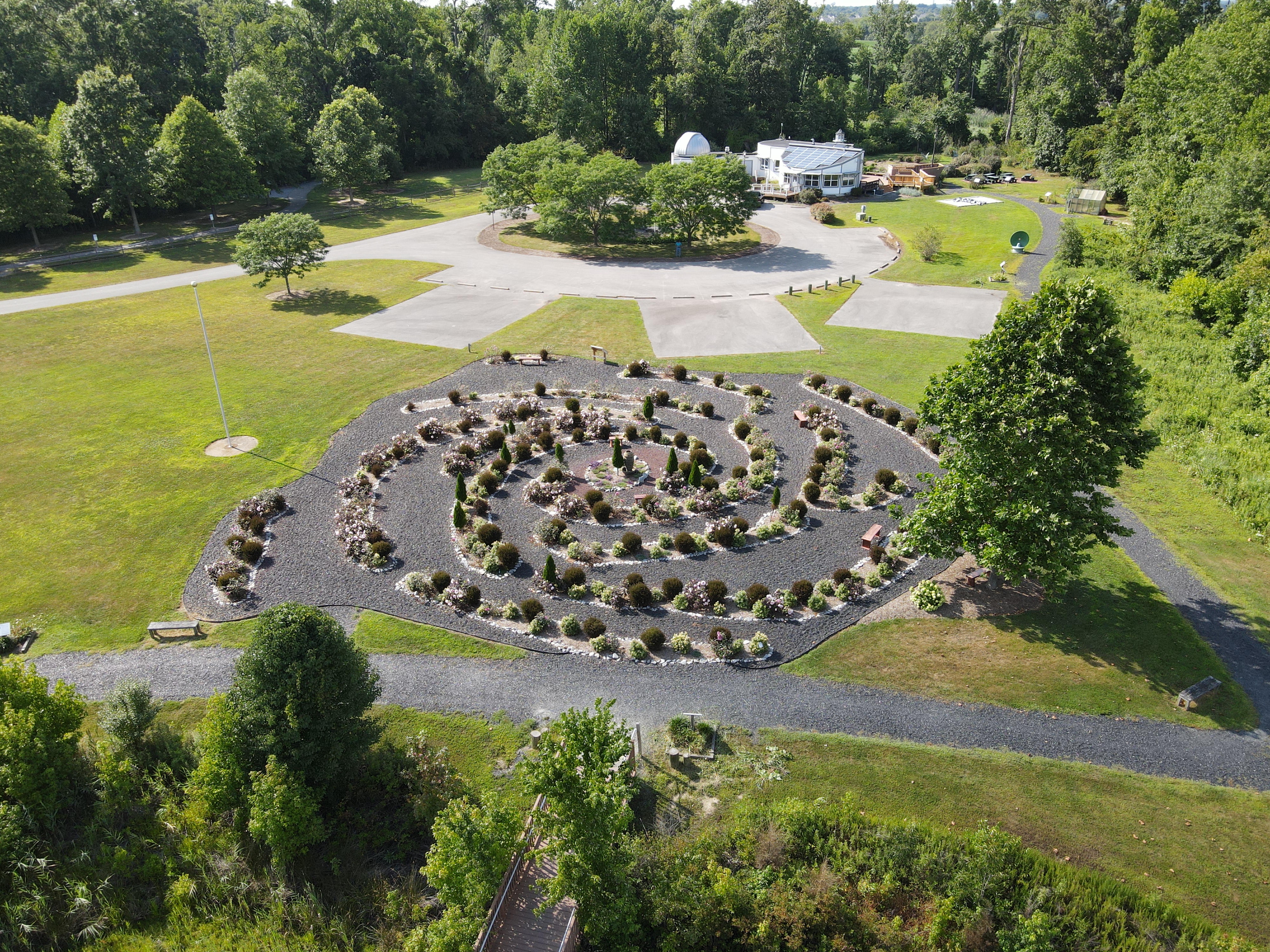
Photo Courtesy of Delaware AeroSpace Education Foundation
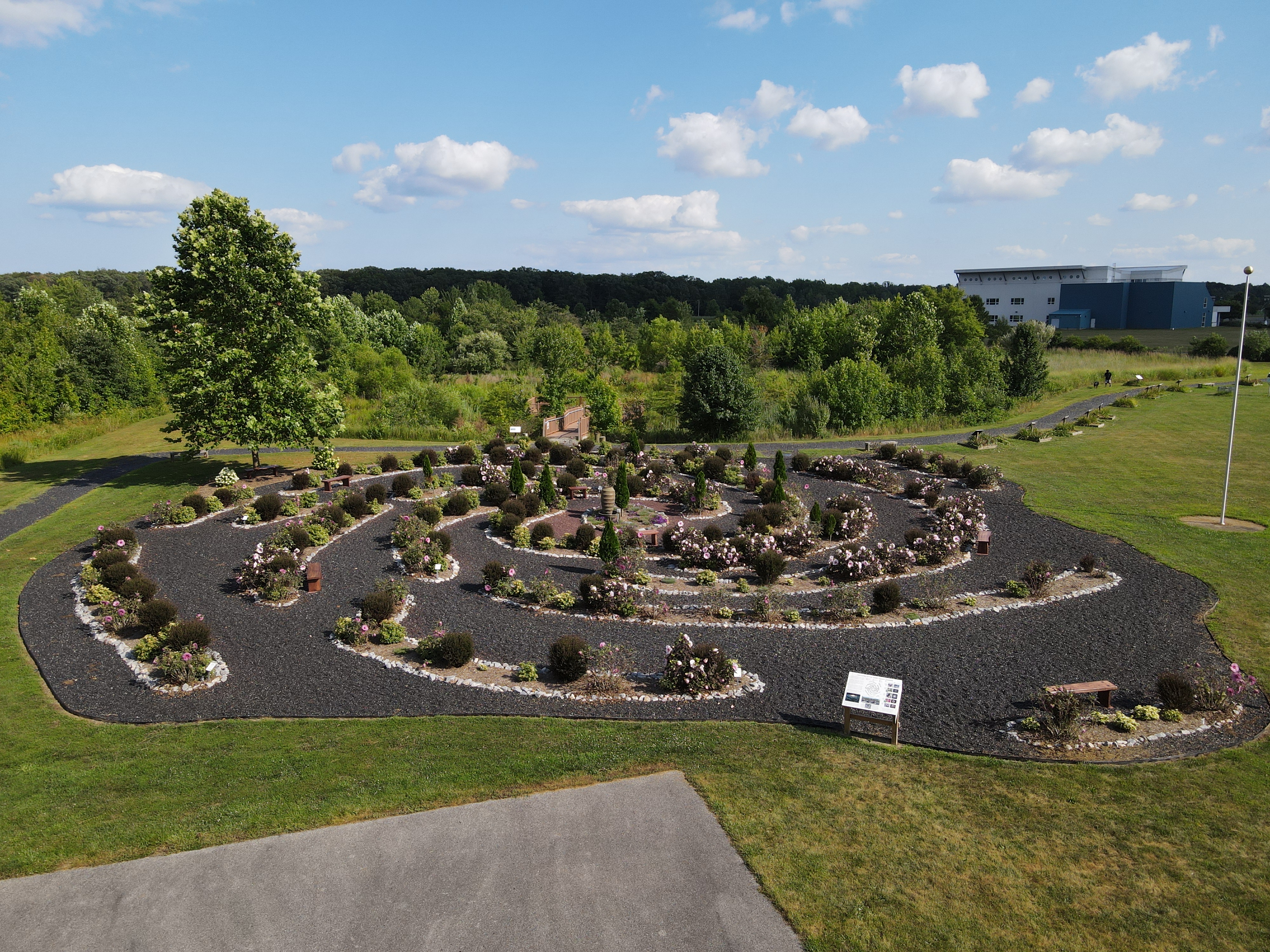
Photo Courtesy of Delaware AeroSpace Education Foundation
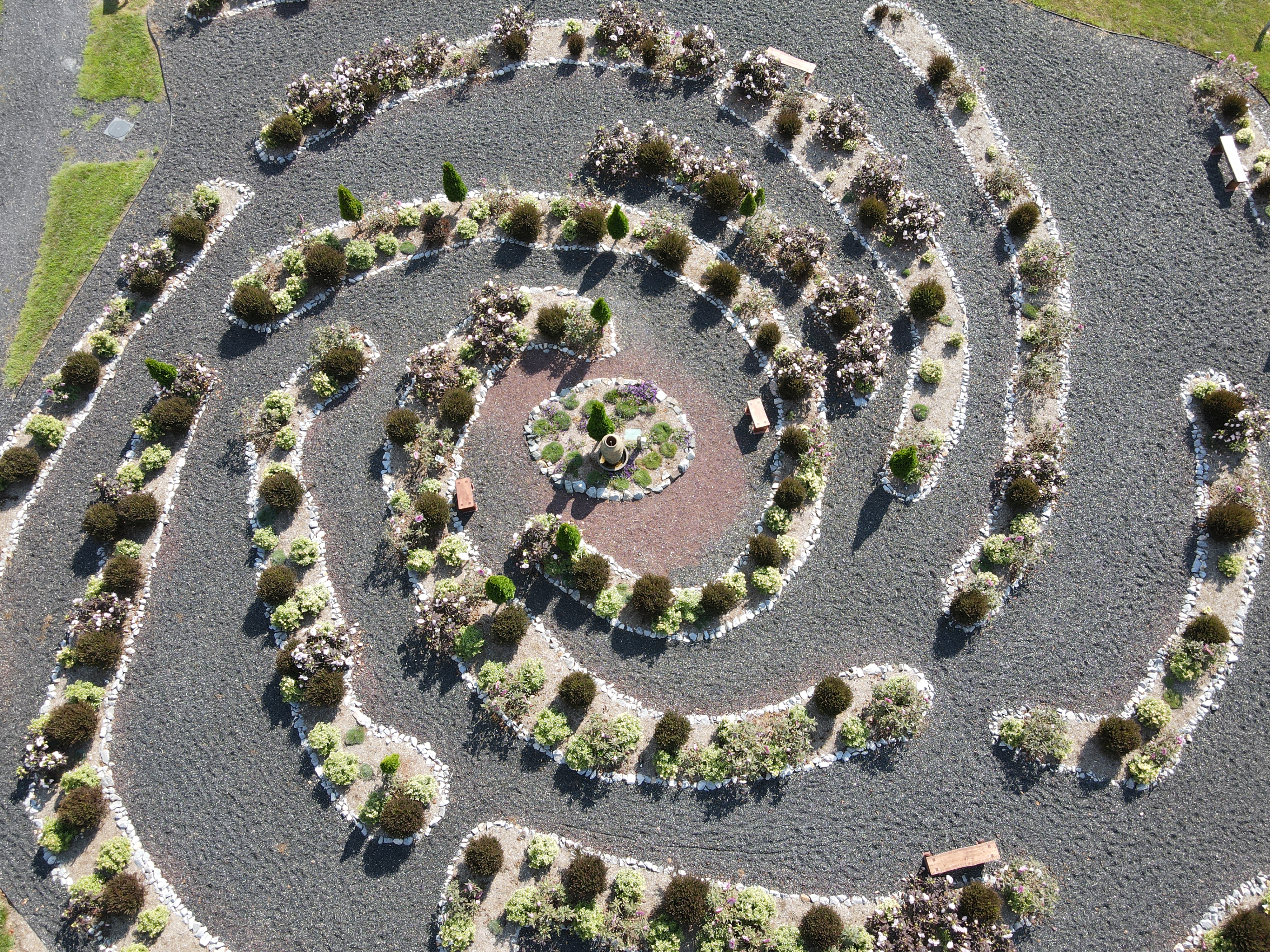
Photo Courtesy of Delaware AeroSpace Education Foundation
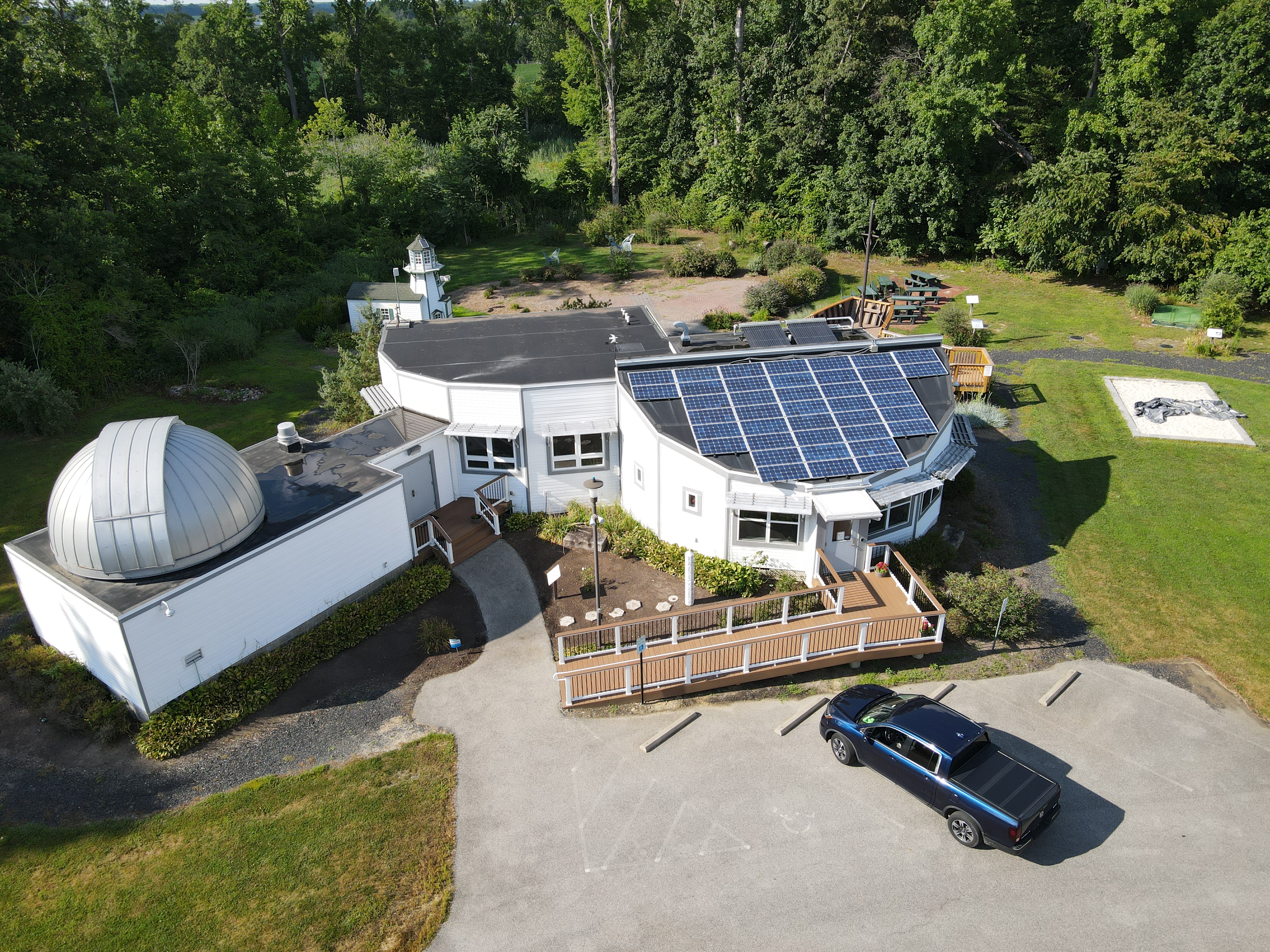
Photo Courtesy of Delaware AeroSpace Education Foundation
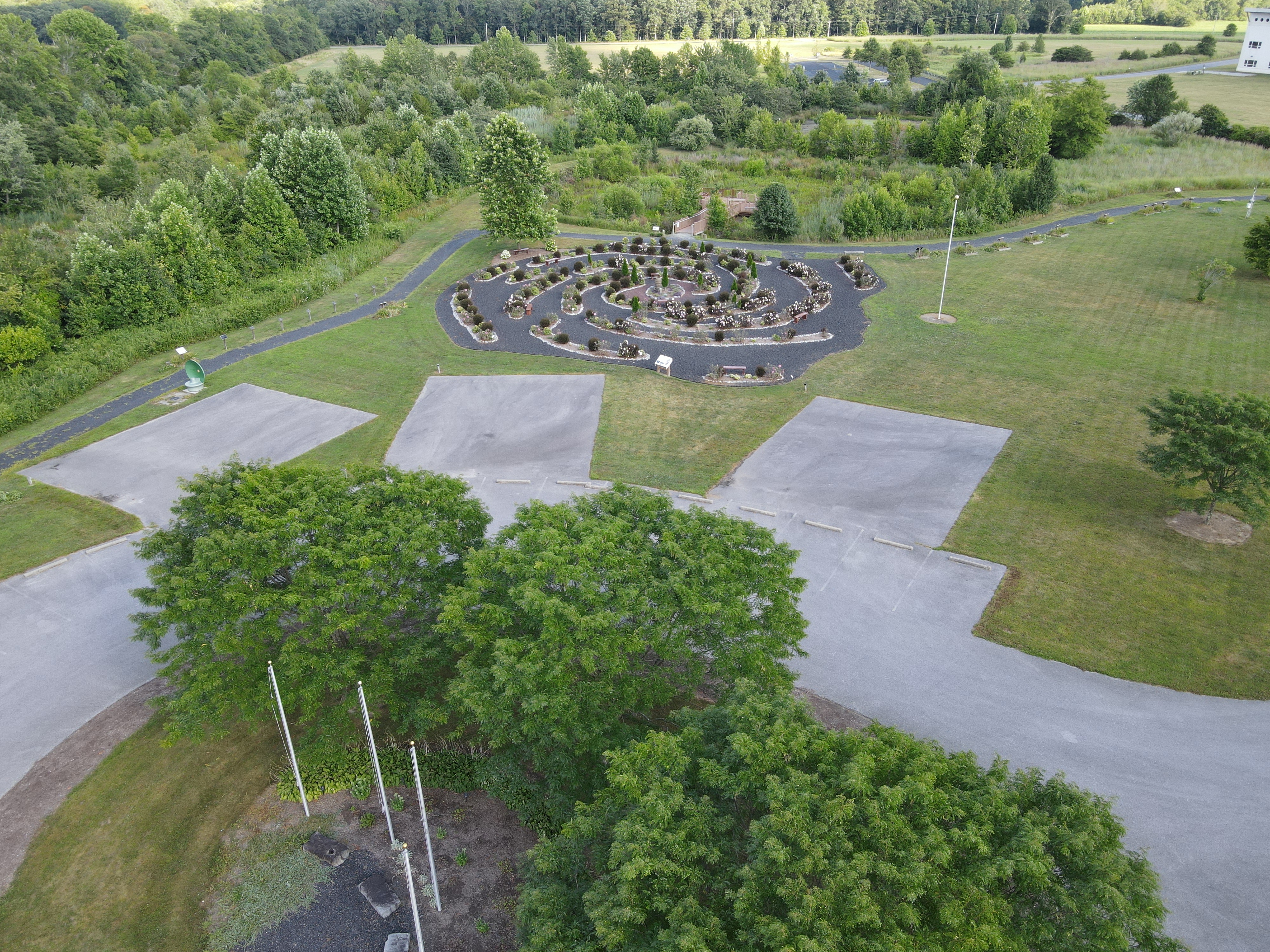
Photo Courtesy of Delaware AeroSpace Education Foundation
An Expanding Universe of Galaxy Gardens
vimeo.com video of a Galaxy Garden at the San Diego Air & Space Museum
Another Galaxy Garden grows in Delaware - read about it here and here
Galaxy Garden brings the Milky Way down to earth

Delaware will be home to the world's second galaxy garden at the Delaware AeroSpace Education Foundation in Smyrna, modeled after the first one by artist Jon Lomberg located on the Big Island of Hawaii where he lives. (Special to The Delaware State News/Doug Curran)

Delaware will be home to the world's second galaxy garden at the Delaware AeroSpace Education Foundation in Smyrna, modeled after the first one by artist Jon Lomberg located on the Big Island of Hawaii where he lives. (Special to The Delaware State News/Doug Curran)

"Wisdom begins with Wonder" is the slogan of the Delaware AeroSpace Education Foundation in Smyrna. (Special to The Delaware State News/Doug Curran)

Lynne Bloom, scheduling coordinator for DASEF, wears a jacket adorned with NASA patches. (Special to The Delaware State News/Doug Curran)

The galaxy garden will be modeled after the first one by artist Jon Lomberg. It’s located on the Big Island of Hawaii where he lives. (Special to The Delaware State News/Doug Curran)

Dr. Stephanie Wright is president and CEO of Delaware AeroSpace Education Foundation. (Special to The Delaware State News/Doug Curran)

Teresa Connor of Magnolia is pleased by what she hears as she listens to artist Jon Lomberg explains the galaxy and its relationship with the stars, planets and black holes at the Wednesday unveiling ceremony for a galaxy garden in Delaware (Special to The Delaware State News/Doug Curran)

Jon Lomberg explains the galaxy and its relationship with the stars, planets and black holes using jewels in variegated plant leaves at the unveiling ceremony for a galaxy garden in Delaware. (Special to The Delaware State News/Doug Curran)

Teresa Connor (left) and Brian Wright (right) listen to Jon Lomberg explain the galaxy and its relationship with the stars, planets, and black holes using jewels in variegated plant leaves at the unveiling ceremony for a galaxy garden in Delaware. Delaware will be home to the world's second galaxy garden at the Delaware AeroSpace Education Foundation (DASEF) in Smyrna, Del., modeled after the first one by artist Jon Lomberg located on the Big Island of Hawaii where he lives. (Special to The Delaware State News/Doug Curran)

Jon Lomberg (left) explains the galaxy and it's relationship with the stars, planets, and black holes using jewels in variegated plant leaves with assistance from (l to r) Bob Bloom, Brian Wright, Debbie Mulholland, and Jacquelyn Jones at the unveiling ceremony for a galaxy garden in Delaware. (Special to The Delaware State News/Doug Curran)

Delaware will be home to the world's second galaxy garden at the Delaware AeroSpace Education Foundation in Smyrna, modeled after the first one by artist Jon Lomberg located on the Big Island of Hawaii where he lives. (Special to The Delaware State News/Doug Curran)
SMYRNA — Jon Lomberg explained the size of the Milky Way galaxy by comparing it to a Gold Dust Croton plant with stud-earrings pierced through some of the leaves.
The leaves were covered with dozens of yellow dots that represented thousands of stars unseen from earth. The earrings represented brighter and bigger components in space like nebulae, solar systems and the black hole.
“That’s a way of letting people understand the scale,” he said. “If the stars I see are that far away, just think how big the galaxy is.”
Mr. Lomberg, a space artist whose pieces won a Primetime Emmy award, used plants and flowers to create the very first Galaxy Garden in Kona, Hawaii — a walkthrough of the Milky Way on a smaller scale.
Dr. Stephanie Wright plans to have the second.
Dr. Wright, academy director of Delaware AeroSpace Education Foundation, organized a media event Wednesday, where she and Mr. Lomberg discussed the future DASEF’s Galaxy Garden and its benefits.
“We have what I call the anchovy’s idea of a pizza,” Mr. Lomberg said as he explained the human’s perspective of the galaxy. “To an anchovy, the pizza doesn’t look round because he’s in it. He would have to get above the pizza in order to see the whole shape.”
The Philadelphia native’s inspiration for the Galaxy Garden was the Giant Heart at the Franklin Institute museum in Philadelphia. The exhibit allows visitors to walk around in a 5,000-square-foot human heart model.
“You get in the heart and walk around; you should get in the galaxy and walk around,” he said. “But it would have to be big, and big suggested outside and outside suggested a garden.”
Mr. Lomberg said gardens and galaxies have similar life cycles.
“A flower makes seeds to make more flowers to make more seeds,” he said. “A nebula makes more stars to make more nebulae to make more stars.”
Dr. Wright sparked the idea of a Galaxy Garden after seeing Mr. Lomberg’s in Sky & Telescope magazine.
After visiting the Galaxy Garden, Dr. Wright brought Mr. Lomberg to DASEF’s Smyrna campus in 2011, and discussed a Galaxy Garden for the Delaware community.
Jean Kraeuter, secretary of the DASEF Executive Board, said the galaxy garden is a spectacular project. It s expected to be completed in 2017.
“To know there’s only one other garden like this is pretty amazing,” she said.
Dr. Qi Lu, physics and engineering professor at Delaware State University, said the garden is an exciting addition to the community.
“It’s a place for locals and beyond to rest, to ponder and to be inspired.”
One of the organizations helping with the Galaxy Garden’s funding is the Optical Science Center for Applied Research at DSU.
Dr. Noureddine Melikechi, director of the OSCAR program, said the donation was inspired by the program’s 12-year relationship with DASEF.
“We’re looking for the public to have a better understanding of science itself,” he said.
He hopes getting youth interested in space science will lead to further engagement with the subject when they’re older.
“[DASEF] has done a wonderful job attracting youth of all backgrounds,” he said. “We need more people in STEM [science, technology, engineering and mathematics].”
The garden is being built in phases.
“If we had all the money to build the whole thing right now, we would,” Dr. Wright said.
Last summer, the electric was installed underground for the black hole representation and the sprinkler system. On May 16, the garden was laid out and outlined with wooden stakes and orange and white spray-paint forming the spiral shape of the Milky Way.
“The next phase we’re moving toward is to at least get the gravel and the paths to be done,” Dr. Wright said.
She said the garden will cost around $20,000.
Kristen Griffith is a Dover freelance writer.
See the original Delaware State News page here.
Garden downsizes Milky Way Galaxy for human observation
Garden is a large scale walk-through representation of Milky Way Galaxy
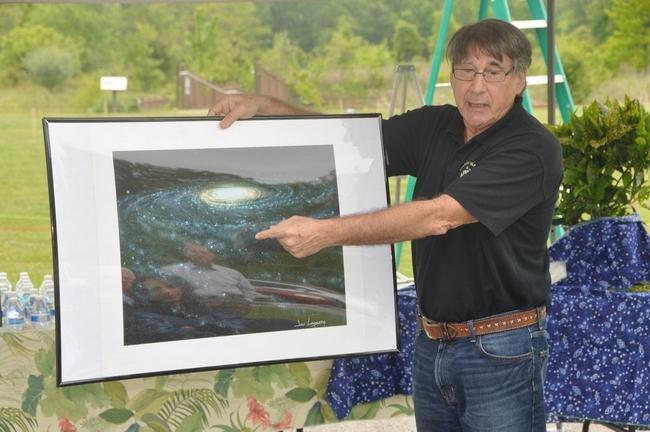
The Delaware Aerospace Education Foundation is taking on an astronomical project.
By working with space artist Jon Lomberg, they’re in the beginning stages of creating a Galaxy Garden at the Big Oak Park in Smyrna.
Lomberg’s Galaxy Garden is a botanical representation of the Milky Way Galaxy. Once its complete visitors will walk through a garden where every plant, leaf and speck mirrors a portion of the Milky Way Galaxy. It’s taking the galaxy and scaling it down for humans to understand.
“The idea of exploring the whole galaxy is like exploring the whole Earth on foot—it’s just too big,” Lomberg said.
At its core is a supermassive black hole, represented by a water fountain. On the outskirts are planets, solar systems and nebulae.
This will be the second Garden Galaxy on the planet. The first garden, created by Lomberg, is in Hawaii.
To represent the millions of stars in the galaxy Lomberg used gold dust plants. The leaves of the gold dust plant have yellow dots. He said each dot equals a number of suns.
“We tried to calculate how many dots we had in our garden and we came up with a few million. But that’s not nearly enough,” he said. “The galaxy has 100 billion stars. So instead of thinking of each dot as being one star think of each dot being 100,000 stars.”
While Lomberg is enthusiastic about the project, he’s aware of the some of the challenges.
“If you’re going to have school groups you don’t want things with thorns, you don’t want things with sap that someone will be allergic too, and you don’t want things that are growing so fast that you’re constantly pruning.”
Choosing drought and insect tolerant plants are also challenging factors to consider, he said. But he’s isn’t going at it alone. He’s going to let the plant experts handle plant selections. That’s why they reached out to members of the Kent County Master Gardeners for assistance.
According to Kate Rutter, who represented the gardeners at Big Oak Park, they are “enthusiastically considering” taking on the project.
“It just seemed overwhelming but intriguing,” Rutter said. “It will be a lot of work. It has to be visually appealing and practical.”
She said the size and growth of the plants will have to conform to the entire plan. She highlighted the fact that the plants will have to enjoy sunlight opposed to plants that prefer the shade.
“There are just so many concepts that have to be worked out,” she said.
Lomberg has experience handling such problems since he started the garden in Hawaii. But that wasn’t always the case.
His first model of the galaxy was a mural he painted, but he wasn’t satisfied with the small scale project. He was partly influenced by the heart display at the Franklin Institute in Philadelphia, where visitors learn about the inner workings of a heart by walking through a large scale model. But he still struggled to make the plan come to fruition.
“It took years for it to really form in my mind because I didn’t really have anything to model it after because there wasn’t anything like it,” he said.
Stephanie Wright, president and CEO of DASEF said they’ve already installed a sprinkler system and power source under the garden. The next step is creating the pathways and installing the necessary plants. She said it’s going to cost $20,000 to get the garden started, but she said the costs are worth it.
“People get frustrated because they can’t imagine what’s out there and this will give them a notion of one galaxy,” she said. “When children walk through there and they see those little leaves—now you get it that’s the Earth within the Milky Way.”
This is Lomberg’s second garden, but he isn’t expecting it to be his last.
“Our ultimate goal is to have a network of galaxy gardens around the world," he said.
See the original Dover Post page here.
Hear Jon Lomberg
YouTube video of Jon Lomberg's talk at the Starship Century conference at UC San Diego on June 18, 2013.
"Becoming Galactic"
In May I gave a talk at the Starship Century conference held at UC San Diego. My talk “Becoming Galactic” was very well received and is now posted on YouTube HERE. Below is a topic breakdown of the 47 minute talk, in case you just want to hear about the Galaxy Garden.
If you would like the unique perspective the Galaxy Garden offers to reach a wider audience, please consider bringing me to do a talk at your institution—possibly to inspire an effort to create a GalaxyGarden ® of your own.
Another way to help is by ordering a Giclee print of Heidy and Pierre Lesage’s wonderful aerial photograph of the garden. I will include a free set of 3 signed storyboard pages from the opening of the movie CONTACT with each Giclee order. Proceeds will go to support efforts in creating more gardens like this. Order HERE.
Here’s a guide to the contents of my talk “Becoming Galactic”
00-11 minutes.....Starships in sf art and movies
11-17 minutes.....Carl Sagan’s COSMOS
17-41 minutes.....Galaxy Garden ®
36-38 minutes.....SETI in the Galaxy Garden
41-47 minutes.....Q & A
Thanks,
Jon








